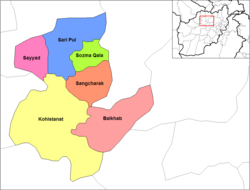Sar-e Pol Province
|
Sar-e Pol سرپل |
|
|---|---|
| Province | |
 Map of Afghanistan with Sar-e Pol highlighted |
|
 Districts of Sar-e Pol |
|
| Coordinates (Capital): 35°36′N 66°18′E / 35.6°N 66.3°ECoordinates: 35°36′N 66°18′E / 35.6°N 66.3°E | |
| Country |
|
| Capital | Sar-e Pol |
| Government | |
| • Governor | Mohammad Zahir Wahdat |
| Area | |
| • Total | 16,360 km2 (6,320 sq mi) |
| Population (2013) | |
| • Total | 532,000 |
| • Density | 33/km2 (84/sq mi) |
| Time zone | UTC+4:30 |
| ISO 3166 code | AF-SAR |
| Main languages |
Dari Uzbeki Pashto |
Sar-e Pol, also spelled Sari Pul (Persian: سرپل; Pashto: سرپل), is one of the thirty-four provinces of Afghanistan, located in the north of the country. It borders Jowzjan and Balkh to the west and north, Ghor Province to the south, and Samangan to the east. The province is divided into 7 districts and contains 896 villages. It has a population of about 532,000, which is multi-ethnic and mostly a tribal society. The province was created in 1988, with the support of northern Afghan politician Sayed Nasim Mihanparast. The city of Sar-e Pol serves as the provincial capital.
Between the early 16th century and the mid-18th century, the territory was ruled by the Khanate of Bukhara. It was given to Ahmad Shah Durrani by Murad Beg of Bukhara after a treaty was signed in or about 1750, and became part of the Durrani Empire. It was ruled by the Durranis followed by the Barakzai dynasty. The area was untouched by the British during the three Anglo-Afghan wars that were fought in the 19th and 20th centuries. It remained peaceful for about one hundred years until the 1980s Soviet war in Afghanistan.
During the Afghan Civil War, the area was controlled by forces loyal to Abdul Rashid Dostum. It was captured by the Taliban in 1998. Aminullah Amin, the first senior member of the Taliban to be captured, was the former governor of the province.
...
Wikipedia
